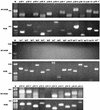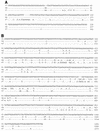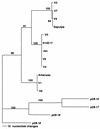Antigenic variation of Ehrlichia chaffeensis resulting from differential expression of the 28-kilodalton protein gene family
- PMID: 11895944
- PMCID: PMC127871
- DOI: 10.1128/IAI.70.4.1824-1831.2002
Antigenic variation of Ehrlichia chaffeensis resulting from differential expression of the 28-kilodalton protein gene family
Abstract
The transcriptional activity and allele variation of the 28-kDa outer membrane protein gene (p28) of Ehrlichia chaffeensis were analyzed to determine the mechanism of the antigenic variation of the 28-kDa outer membrane proteins. Reverse transcriptase PCR amplification of mRNA indicated that 16 of the 22 members of the p28 multigene family were transcribed. Amino acid sequence analysis indicated that the p28-19 protein was produced in vitro in the Arkansas strain. The p28-19 gene and its promoter region were sequenced and compared in 12 clinical isolates of E. chaffeensis to determine allele variation. The variation of the p28-19 gene among the isolates is limited to three types represented by strains Arkansas, 91HE17, and Sapulpa, respectively. These results indicate that the majority of the p28 genes are active genes and that antigenic variation of the E. chaffeensis 28-kDa proteins may result from differential expression of the p28 gene family members rather than gene conversion.
Figures





Similar articles
-
Genetic diversity of the 28-kilodalton outer membrane protein gene in human isolates of Ehrlichia chaffeensis.J Clin Microbiol. 1999 Apr;37(4):1137-43. doi: 10.1128/JCM.37.4.1137-1143.1999. J Clin Microbiol. 1999. PMID: 10074538 Free PMC article.
-
Immunodominant major outer membrane proteins of Ehrlichia chaffeensis are encoded by a polymorphic multigene family.Infect Immun. 1998 Jan;66(1):132-9. doi: 10.1128/IAI.66.1.132-139.1998. Infect Immun. 1998. PMID: 9423849 Free PMC article.
-
Characterization of the complete transcriptionally active ehrlichia chaffeensis 28 kDa outer membrane protein multigene family.Gene. 2000 May 2;248(1-2):59-68. doi: 10.1016/s0378-1119(00)00147-5. Gene. 2000. PMID: 10806351
-
Unique macrophage and tick cell-specific protein expression from the p28/p30-outer membrane protein multigene locus in Ehrlichia chaffeensis and Ehrlichia canis.Cell Microbiol. 2006 Sep;8(9):1475-87. doi: 10.1111/j.1462-5822.2006.00727.x. Cell Microbiol. 2006. PMID: 16922866
-
Restriction and expansion of Ehrlichia strain diversity.Vet Parasitol. 2007 Feb 28;143(3-4):337-46. doi: 10.1016/j.vetpar.2006.08.027. Epub 2006 Sep 22. Vet Parasitol. 2007. PMID: 16996215 Review.
Cited by
-
Virulence potential of Ehrlichia chaffeensis strains of distinct genome sequences.Infect Immun. 2007 Jul;75(7):3604-13. doi: 10.1128/IAI.02028-06. Epub 2007 Apr 16. Infect Immun. 2007. PMID: 17438035 Free PMC article.
-
Progress and obstacles in vaccine development for the ehrlichioses.Expert Rev Vaccines. 2010 Sep;9(9):1071-82. doi: 10.1586/erv.10.93. Expert Rev Vaccines. 2010. PMID: 20822349 Free PMC article. Review.
-
Total, membrane, and immunogenic proteomes of macrophage- and tick cell-derived Ehrlichia chaffeensis evaluated by liquid chromatography-tandem mass spectrometry and MALDI-TOF methods.Infect Immun. 2008 Nov;76(11):4823-32. doi: 10.1128/IAI.00484-08. Epub 2008 Aug 18. Infect Immun. 2008. PMID: 18710870 Free PMC article.
-
Targeted and random mutagenesis of Ehrlichia chaffeensis for the identification of genes required for in vivo infection.PLoS Pathog. 2013 Feb;9(2):e1003171. doi: 10.1371/journal.ppat.1003171. Epub 2013 Feb 14. PLoS Pathog. 2013. PMID: 23459099 Free PMC article.
-
Molecular heterogeneity of Ehrlichia chaffeensis isolates determined by sequence analysis of the 28-kilodalton outer membrane protein genes and other regions of the genome.Infect Immun. 2003 Jan;71(1):187-95. doi: 10.1128/IAI.71.1.187-195.2003. Infect Immun. 2003. PMID: 12496165 Free PMC article.
References
-
- Andrew, H. R., and R. A. Norval. 1989. The carrier status of sheep, cattle and African buffalo recovered from heartwater. Vet. Parasitol. 34:261-266. - PubMed
-
- Chen, S. M., X. J. Yu, V. L. Popov, E. L. Westerman, F. G. Hamilton, and D. H. Walker. 1997. Genetic and antigenic diversity of Ehrlichia chaffeensis: comparative analysis of a novel human strain from Oklahoma and previously isolated strains. J. Infect. Dis. 175:856-863. - PubMed
-
- Dawson, J. E., J. E. Childs, K. L. Biggie, C. Moore, D. Stallknecht, J. Shaddock, J. Bouseman, E. Hofmeister, and J. G. Olson. 1994. White-tailed deer as a potential reservoir of Ehrlichia spp. J. Wildl. Dis. 30:162-168. - PubMed
Publication types
MeSH terms
Substances
Grants and funding
LinkOut - more resources
Full Text Sources

